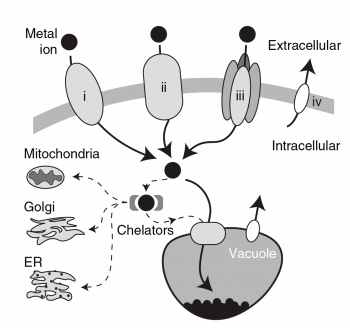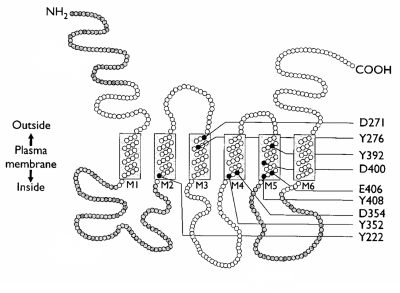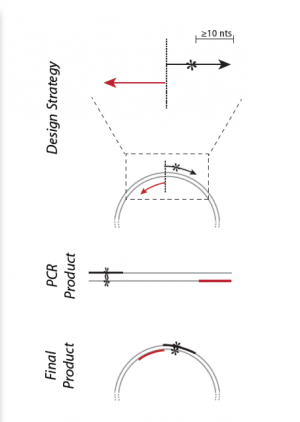20.109(S23):M2D1
Contents
Introduction

Today you examine what is known about the Saccharomyces cerevisiae metal permease, Fet4, and use that information to choose a rationally-designed mutation in an effort to increase the ability of the transporter to take up the heavy metal cadmium. To do this, you will familiarize yourself with the primary and tertiary structure of Fet4 and also study the effects of previous mutations on transporter function.
Protocols
Part 1: Review Fet4 reference article and database entry
In this module, we will attempt to alter the affinity of the S. cerevisiae low-affinity iron transporter, Fet4, to preferentially take up cadmium from the extracellular environment. We will employ a rational design approach to change specific amino acids in the Fet4 protein sequence in order to alter transporter affinity for cations. In order to guide your rational design, the lab today will encourage you to consult resources in the literature and field to determine which modifications are most promising. You will begin by examining one of the first characterizations of the Fet4 protein.
With your partner, review the information regarding the characterization of Fet4 in the paper by Dix et. al. (attached here). Specifically, you will focus on the membrane topology in Figure 1 (shown to the right) and the point mutations the authors created to alter transporter uptake of iron. These point mutations are also shown in Figure 1 and characterized in Figure 8.
In your laboratory notebook, complete the following:
- How did the authors determine their proposed topology of Fet4? What are the benefits and limitations of this approach?
- Why did the authors chose to use alanine to replace the amino acid residues they targeted?
- Which mutations had limited effect on iron uptake kinetics? Which abolished the ability of Fet4 to take up iron?
- What mutations had a moderate effect of iron uptake kinetics?
- Are there any topology commonalities shared by the different groups of mutants discussed in Table 1?
- What biological issue would explain the abolishment of iron uptake by E406A?
- Based on the information presented in this paper, on which region(s) might you focus if you want to alter Fet4 affinity for iron?
While not extensive, additional characteristics have been predicted in the InterPro database entry for Fet4. InterPro is an aggregate database that uses models from multiple protein databases to make predictions about functional domains of proteins. To glean more predicted information about Fet4 protein structure and function, enter P40988 into the search bar. This is the designation for the S. cerevisiae Fet4 with which you will be working. Examine the different predicted features of the protein and record your observations in your lab notebook.
In your laboratory notebook, complete the following:
- How many transmembrane domains are predicted for Fet4 in this database? Does it match the predictions of Dix. et. al?
- What amino acids comprise the predicted permease domains of Fet4? In which predicted transmembrane domains are the permease domains found?
Part 2: Examine Fet4 structural elements
In the previous section you reviewed primary scientific literature to examine Fet4 topology and potentially interesting mutations in the Fet4 sequence. Now you will examine 3D representations of Fet4 topology to further examine potentially relevant amino acid residues.
- You will first examine the structure of Fet4 using AlphaFold (linked here).
In your laboratory notebook, complete the following:
- Based on
Part 3: Examine literature for cadmium affinity and uptake
Now that you have noted relevant information regarding the Fet4 transporter, it's time to turn your attention to our metal of interest, cadmium. While there is limited information on the specific mechanism of transporter-mediated cadmium uptake into cells, previous literature has indicated that amino acid residues form complexes of differing stability with cadmium. A detailed overview of this chemistry can be found here with the tables in the attached document providing the most relevant numbers.
In your laboratory notebook, complete the following:
- Based on the information above, which amino acids are most likely to show a preference for cadmium binding?
Finally, it is helpful to have previous examples of successful mutagenesis to guide your design rationale. For this, please examine the paper that inspired this module (attached here). The Belcher lab at MIT previously mutagenized a manganese transporter (SMF1) and found a set of point mutations which improved affinity of SMF1 for cadmium. They used the pfam database and structural modeling to identify transmembrane domains 1 and 6 as the most relevant for SMF1 transport of cadmium. They then created point mutations to test for alterations in cadmium uptake. While this paper contains a great deal of useful information, please focus on Figure 5a-b and the accompanying text for this exercise. Please examine the reported location of the point mutations for SMF1 and note their effects on cadmium uptake.
In your laboratory notebook, complete the following:
- Which mutations in SMF1 had the largest effect on cadmium uptake?
- Was a single point mutation able to alter cadmium uptake? What was the magnitude of the effect on cadmium and manganese uptake?
Part 4: Identify amino acid substitution target for Fet4_mutant
Using the information you have gathered above, you can now determine a Fet4 mutation that will potentially alter the transportation of cadmium. After you choose which amino acid you think is the best target for altering affinity, consider what amino acid you want to include instead.
In your laboratory notebook, complete the following:
- What amino acid will you target using SDM? At what position is this amino acid located in the protein sequence? What amino acid will be incorporated in its place?
- Provide the rational for your design choice.
- Why do you think the target amino acid you selected will alter affinity for cadmium?
- How do you think the amino acid substitution will alter affinity for cadmium?
Part 5: Design primers for site-directed mutagenesis
It is not experimentally efficient, or entirely plausible, to pick out and modify a single amino acid residue in the Fet4 transporter post-translationally. Instead researchers genetically encode for amino acid substitutions by incorporating mutations in the DNA sequence. This is accomplished by making changes to the basepairs of a gene of interest that was cloned into a plasmid. Then the plasmid with the mutated gene is amplified using bacterial cells.
Primers used in SDM must meet several design criteria to ensure specificity and efficiency. Consider the following design guidelines for mutagenesis primers:
- Desired mutation (1-2 bp) must be present in the middle of the forward primer.
- Forward and reverse primers should 'face' away from the mutation and be 'back-to-back' when annealed to the template.
- Primers should be 25-45 bp long.
- G/C content of > 40% is desired.
- Both primers should terminate in at least one G or C base.
- Melting temperature should exceed 78°C, according to:
- Tm = 81.5 + 0.41 (%GC) – 675/N - %mismatch
- where N is primer length and the two percentages should be integers
To demonstrate primer design, the illustration below uses S101L, which is an uninteresting mutation but a helpful example:
Residue 101 of the protein calmodulin is serine, encoded by the AGC codon.
361 (5') GAG GAA ATC CGA GAA GCA TTC CGT GTT TTT GAC AAG GAT GGG AAC GGC TAC ATC AGC GCT (3')
381 (5') GCT CAG TTA CGT CAC GTC ATG ACA AAC CTC GGG GAG AAG TTA ACA GAT GAA GAA GTT GAT (3')
To change from serine to leucine, one might choose TTA, TTG, or CTN (wherer N = T, A, G, or C). Because CTC requires only two mutations (rather than three as for the other options), we choose this codon.
Now we must keep >10 bp of sequence on each side in a way that meets all our requirements. To quickly find G/C content and see secondary structures, look at the IDT website. (Note that the Tm listed at this site is not one that is relevant for mutagenesis.)
Ultimately, your forward primer might look like the following, which has a Tm of almost 81°C, and a G/C content of ~58%.
5’ GG AAC GGC TAC ATC CTC GCT GCT CAG TTA CGT CAC G 3'
The reverse primer is the inverse complement of a sequence just preceding the forward primer in the IPC gene. The forward and reverse primers are set up back-to-back.
Luckily, online tools are available to assist with SDM primer design. Today you will use NEBaseChanger (provided by NEB) to design your mutagenic primers.
- Go to the NEBaseChanger site and click 'Please enter a new sequence to begin.'
- A new window will open.
- Download the WT Fet4 sequence here.
- Copy the sequence from this file into the NEB window.
- Confirm that the 'Substitution' option is selected.
- Highlight the basepairs you want to mutate using by scrolling through the sequence, or you can search the sequence by typing the basepairs into the 'Find' box.
- Type the new DNA sequence (the basepair(s) you want your forward mutagenic primer to incorporate into the Fet4 sequence) in the 'Desired Sequence' box.
- Under the Result header, a diagram showing where your primers will anneal is provided.
- Under the Required Primers header, the sequences for your forward primer and reverse primer are shown with the characteristics for each.
In your laboratory notebook, complete the following:
- Include a screen capture of the information provided in the Result and Required Primers sections.
- Use the guidelines provided above to examine the mutagenesis primers designed by NEBaseChanger. Do the primers meet the design criteria?
- Copy your forward and reverse primer sequence and upload them to the Class Data page on the wiki before you leave.
- These primers must be ordered tonight to arrive in time for your next experiment.
Next day: Perform site-directed mutagenesis

